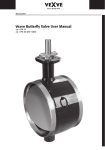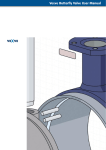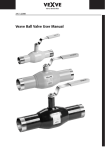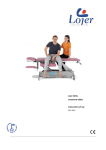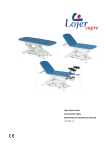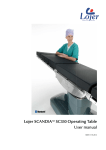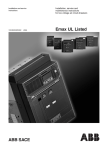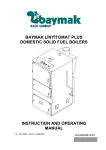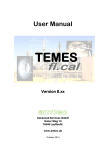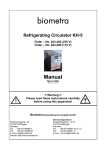Download Vexve Ball Valve User Manual
Transcript
21.06.2011 Vexve Ball Valve User Manual Vexve Ball Valve User Manual Table of Contents 1. General 2. Precautions and Notifications 3. Markings 4. Valve Transportation and Storage 5. Installations and Welding to the Pipeline 5.1 Welding 6. Commissioning and Use 7. Maintenance 7.1 Assembly/Disassembly of Ball Valve Manual Gear 7.2 Assembly/Disassembly of Manual and Electric Actuators (Auma) 7.3 Assembly/Disassembly of Pneumatic Actuators 8. Maximum Allowable Pressure at Different Temperatures 9. Kv Value Chart 7.1.1 The Adjusting/Assembly of the Manual Gear 10. Materials 1. General Vexve Steel Ball Valves (Colour blue) Vexve fully welded ball valve is designed for clean mediums and to be used in e.g. district heating pipelines, oil pipelines, and in general at pipeline applications where the water is oxygen-free. Please consult with the manufacturer on other applicable applications. The valve body is from pressure equipment steel. The shaft and ball are manufactured from the stainless steel material. The ball seals are carbonized Teflon (PTFE). The stem sealing is done by the O-rings. The O-rings are FPM (viton) rubber material. The valve is bi-directionally tight. The valve opens when turning the manual gear to clockwise. The position indicator line at the end of the stem shows the the ball’s position versus the stem. When the valve is open the handle is aligned with pipeline. Also the indicator at the top of the stem is in line with the pipeline. Vexve Oy is not responsible for the damages caused by unknown subjects or dirtiness. Vexve Oy is also not responsible for the damages caused by improper handling or delivery. 2 Vexve Ball Valve User Manual Vexve Stainless Steel Valve (Colour grey) Vexve fully welded stainless steel ball valve is designed for clean mediums and to be used in e.g. at the process applications. The valve is applicable e.g. most of the acids or different types of waters, and e.g. certain calsium, sodium or potassium applications. Please consult with the manufacturer on the suitability and also on the other applicable applications. The valve body is from pressure equipment steel (stainless). The shaft and ball are manufactured from the stainless steel material. The ball seals are carbonized Teflon (PTFE). The stem sealing is done by the O-rings. The O-rings are FPM (viton) rubber material. The valve is bi-directionally tight. The valve opens when turning the manual gear to clockwise. The position indicator line at the end of the stem shows the ball’s position versus the stem. When the valve is open the handle is aligned with pipeline. Also the indicator at the top of the stem is in line with the pipeline. Vexve Oy is not responsible for the damages caused by unknown subjects or dirtiness. Vexve Oy is also not responsible for the damages caused by improper handling or delivery. Vexve Gas Valve (Colour yellow) Vexve fully welded shut-off gas ball valve is designed for natural gas transmission pipelines. Please consult with the manufacturer, when the valve is used for other medium or applications. The valve body is from pressure equipment steel. The shaft and ball are manufactured from the stainless steel material. The ball seals are carbonized Teflon (PTFE). The stem sealing is done by the O-rings. The O-rings are NBR rubber material. The valve is bi-directionally tight. The valve opens when turning the manual gear to clockwise. The position indicator line at the end of the stem shows the ball’s position versus the stem. When the valve is open the handle is aligned with pipeline. Also the indicator at the top of the stem is in line with the pipeline. Vexve Oy is not responsible for the damages caused by unknown subjects or dirtiness. Vexve Oy is also not responsible for the damages caused by improper handling or delivery. 3 Vexve Ball Valve User Manual 2. Precautions and Notifications Please read and notify the following instructions before handling and operating the Vexve ball valves: • Check the valve’s suitability to the medium and application. • Check that the manufacturer’s informed maximum temperature and pressure ranges are not exceeded (chapter 8) • Do not heat the valve unnecessary from outside. • The installed valve at pipeline can be extremely hot! Be protected!. • The valve may not be used alone as a pipeline ending fitting. Always after the valve a blank flange needs to be welded or/and connected to the pipeline end. • The manual gear or actuator may not been removed or dismantled if the valve is pressurized or/and it has flow. • The valve should be un-pressurized when changing the stem O-ring(-s). • If the pipeline is classified (I-III), according to Equipment Directive (PED) 97/23/EC, check from the seller that the valve’s classification meets the pipelines classification. • When valve is operated with electric or pneumatic actuator in cooling systems, it’s not recommended to install stem of the valve downwards, due to the condensation risk. 3. Markings The identification plate locates at the valve body. It has the following information: 1 1. Valve DN size 2. Pressure class 3. Valve Body Material 4. Maximum Allowable Temperature 5. Valve type 6. Valve DN size 7. CE-Mark and the number PN 40 2 Material: 1.0345 3 T min... T max: 0...200 ºC Product no: 100050 4 6 5 of the notified body 8. Russian Valve Certification DN 50 0575 7 8 9. Belarus Valve Certification 10.Manufacturer 11 9 11.Manufacturing Year 12.Manufacturer’s Internet Site 2009 www.vexve.fi 10 4 12 Vexve Ball Valve User Manual 4. Valve Transportation and Storage Please check that the valve or its parts are not damaged during the transportation. Please also check that the content of the delivery (valve types, sizes, etc.) is according to agreement. The information on the possible damages or deviations in the content must be informed immediately to Vexve Oy. Store the valve at clean and dry storage before the installation. Do not remove the flow port protectors before the installation. Use lifting ropes when lifting the large size valves. It is forbidden to lift the valve from its actuator or stem. If needed, please check the valve’s weight from Vexve Oy. 5. Installations and Welding to the Pipeline The pipelines must be cleaned properly before installing the valves, otherwise the impurities may damage the valve surfaces. During the cleaning/checking, check also that the is no dirtiness at valve due the storage or transportation. Check that the valve’s maximum and minimum temperatures are not exceeded! The maximum operational pressures and temperatures can be found from the valve identification plate. Do not remove the manual gear or actuator from the valve. If the manual gear or actuator needs to be removed during the installation, please follow the actuator manufacturer’s instructions how to adjust the actuator when reassembled (chapter 7). To minimise the pressure shocks (in sizes DN 150/6” and bigger); it is recommended to use bypass valve. 5 Vexve Ball Valve User Manual 5.1 Welding It is recommended to use the electric welding (TIG, MIG). Valve size DN 125 and bigger must be welded to the pipeline by using electric welding. WELDING Do not overheat the valve. Use cooling during the welding. Use wet fabric to protect the valve seat from excess heat during the welding. The welder should have the proper qualification to do this kind of welding procedures. WHEN VALVE IS INSTALLED IN A HORIZONTAL POSITION: When welding the valve, it must be in the open position - this avoids welding contamination to get in touch with the ball surface. WHEN VALVE IS INSTALLED IN A VERTICAL POSITION: When making the upper seam welding, the valve must be open to avoid welding contamination to get in touch with the ball surface. When making the lower welding seam the valve must be closed to avoid the overheating of the valve. Cool down the valve (after welding) before normal operation. The valve may not be opened or/and closed after the welding before it has cooled down. 6 Vexve Ball Valve User Manual 6. Commissioning and Use The pipeline needs to be flushed carefully after the valve installation. Commissioning Test Pressures The largest allowable testing pressure is 1,1xPN, when the valve is closed. During the pipeline pressure testing (1,5xPN), the valve needs to be open. The shut-off valves are designed to be fully open or close. Check that the valve is either in open or close position against the stopper (by turning the handle 90 degrees). The valve may not be used alone as a pipeline ending fitting. Always after the valve a blank flange needs to be welded or/and connected to the pipeline end. When discharging the pipelines the valve has to be turned into a half-open position in order to remove all liquid behind the ball. Important when the pipelines are discharged in temperatures below 0 ºC. 7. Maintenance The valves do not need extra service at the normal conditions, but to guarantee the good working of the valves, opening and closing of the valve couple times in a year is highly recommended. Change of O-rings If needed, the upper O-ring(-s) of the stem can be replaced without draining the pipelines. Follow the instructions, when changing the O-ring. Take care of all special circumstances and when needed, contact the manufacturer. The instructions can be found from the Internet www.vexve.fi or directly from the manufacturer. 7 Vexve Ball Valve User Manual 7.1 Assembly/Disassembly of Ball Valve Manual Gear NOTE! The manual gear or actuator may not been removed or dismantled if the valve is pressurized! NOTE! It is recommended to use the special actuator removal tools! 1. Turn the valve to the open position before the gear removal. The valve opens when turned the gear handle to the counter-wise direction. 2. Turn the hand wheel slightly closed (to the point when the wheel turns easily) 3. Before the gear removal, remove the position indicator plate’s bolts (2), indicator plate (3) and mark the shaft position to the actuator’s bush.(1). 4. Remove the actuator’s bolts and remove the actuator. When assembling the manual gear, check that the stem bush adapter is in its original position. There is no need to set the gear/actuator settings again when assembled to the original position. If wanted to turn the gear/actuator 180 degrees, then the setting and fine- tuning needs to be done according to the chapter 5. Install and tighten the bolts of the actuator/gear. 7.1.1 The Adjusting/Assembly of the Manual Gear 1. Turn the valve to the open position 2. Turn the gear to the open position. Clean the shaft (at the gear) and the bush. Crease the manual gear’s bush (e.g. Spray Vaseline Würth HHS 2000) 3. Install the manual gear so that the hand wheel locates at the preferred position 4. Crease and install the nuts, screws and plates 5. Install the hand wheel to the manual gear 6. Turn the valve to open position. 7. Turn the valve to open position. The exact position will be checked from the valve shaft. The ball needs to be centred to the seals. If you turn the valve too much open, then the 6. and 7 items need to be done once again. 8. Remove the caps from the stop screws (4). 9. Open and loose the locking screws. 10.Tighten the open position stop screw (7) and lock the screw with the locking screw (5). 11.Turn the ball 90 degrees closed. 12.Tighten the stop position screw (6) and lock the screw with locking screw (5). 8 Vexve Ball Valve User Manual 2 3 1 7 6 5 4 9 Vexve Ball Valve User Manual 7.2 Assembly/Disassembly of Manual and Electric Actuators (Auma) NOTE The manual gear or actuator may not been removed or dismantled if the valve is pressurized! It is recommended to use the special actuator removal tools! 1. Turn the valve to the open position before the actuator removal by turning the manual gear’s wheels. 2. Turn the power off (for the actuator) 3. Turn the handle a bit close so that that the valve wheel/spindle turns easily. 4. Before the gear removal, mark the position and place of the bushing (1) against to the valve and the actuator. 5. Remove the actuator’s bolts and remove the actuator. The bushing (1) will stay at the stem. 6. When assembling the manual gear, check that the stem bush adapter is in its original position. There is no need to set the gear/actuator settings again when assembled to the original position. If wanted to turn the gear/actuator 180 degrees, then the setting and fine- tuning needs to be done according to the chapter “manual gear adjusting”. 7. Install the actuator, and tighten the bolts of the actuator/gear. Ball Valve Actuator Adjusting (Manual Gear and Electric Actuator (AUMA)) 1. Turn the valve to open position 2. Place the bushing to the right level/height. The height needs to be measured from the gear. Tighten the locking screw (6) with the hexagon key. 3. Turn the gear/actuator to open position, and install the manual gear so that the hand wheel comes to the preferred direction. 4. Crease, install and tighten the manual gears/actuators bolts. 5. Install the hand wheel to the gear/actuator. 6. Turn the hand wheel couple of turns to open the valves. Remove the limiting bush’s (8) fastening screws (7) so the bush can turn freely. 7. Turn the valve to the open position. The exact position will be checked from the valve shaft. The ball needs to be centred to the seals. If you turn the valve too much open, then the 6. and 7 items need to be done once again. 8. After finding the right open position has been found, turn the limiting bush slightly to clockwise direction to position where it does not move anymore. Then turn back the bush app. 1/8 turn. Pull the bush out of its bores (app. 2cm) and install the limiting bush back to its place so that the holes of the bush are in the line with the gear’s holes. 10 Vexve Ball Valve User Manual 8. After finding the right open position has been found, turn the limiting bush slightly to clockwise direction to position where it does not move anymore. Then turn back the bush app. 1/8 turn. Pull the bush out of its bores (app. 2cm) and install the limiting bush back to its place so that the holes of the bush are in the line with the gear’s holes. AUMA GS 160 and larger gears the limiting bush does not need to pull out of its bores. In larger valves, the bush will be tightened directly to the right position with the flanges. 9. Turn the valve closed. Check that the closed positioner/limit is at right position. 10.Turn the power on to the electric actuator and install the limit switches and moment switches according to the AUMA’s instructions. 2 3 4 5 8 7 6 1 7.3 Assembly/Disassembly of Pneumatic Actuators NOTE! The manual gear or actuator may not been removed or dismantled if the valve is pressurized. It is recommended to use a special tools and equipment (designed for actuator removal) when disassembling the valve. Assembly and disassembly will be done according to the actuator manufacturer’s instructions; and also at the same time following/notifying the maximum torque values. 11 Vexve Ball Valve User Manual 8. Maximum Allowable Pressure at Different Temperatures MPa DN 10 – DN 50 PN 40 4 3 DN 65 – DN 600 PN 25 2 1 -30 0 +30 60 90 120 150 180 210 °C Contact the manufacturer, if the temperature is below 0 ºC. 9. Kv Value Chart Kv Values when Valve Fully Open: Reduced bore valves DN 10 15 20 25 32 40 50 65 80 KV 8 8 14 25 41 65 103 180 290 DN 100 125 150 200 250 300 350 400 500 600 KV 470 830 1150 1750 3200 4600 6600 13300 18700 29800 Full bore valves DN 15 20 25 32 40 50 65 80 100 KV 14 25 41 65 103 180 290 470 830 DN 125 150 200 250 300 350 400 500 600 KV 1150 1750 3200 4600 9600 13300 18700 30000 65000 12 Vexve Ball Valve User Manual 10. Materials Steel Valves (blue) 7. 9. 2. 8. 1. 6. 5. 3. 4. No Description Material 1. Body Steel, EN 10217-2 P235GH (1.0345) 2. Stem bush Steel 3. Ball Stainless Steel, EN X5CrNi18-10 (1.4301) 4. Stem Stainless Steel, EN X5CrNiS18-9 (1.4305) 5. Ball Seals Carbonized PTFE 6. Extension pipes Steel, EN 10217-2 P 235GH (1.0345) 7. Handle Galvanized Steel 8. O-ring FPM 9. Bush PTFE No Description Material 1. Body Stainless Steel, EN 10217-7 X2CrNiMo17-12-2 (1.4404) 2. Stem bush Stainless Steel, EN X2CrNiMo17-12-2 3. Ball Stainless Steel, EN X2CrNiMo17-12-2 4. Stem Stainless Steel, EN X2CrNiMo17-12-2 5. Ball Seals Carbonized PTFE 6. Extension pipes Stainless Steel, EN 10217-7 X2CrNiMo17-12-2 (1.4404) 7. Handle Stainless Steel 8. O-ring FBM / NBR 9. Bush PTFE Stainless Steel Valve (grey) 7. 9. 8. 2. 1. 6. 5. 3. 4. 13 Vexve Ball Valve User Manual Gas Valve (yellow) 7. 9. 2. 8. 1. 6. 5. 3. 4. 14 No Description Material 1. Body Steel, EN 10217-2 P235GH (1.0345) 2. Stem bush Steel 3. Ball Stainless Steel, EN X5CrNi18-10 (1.4301) 4. Stem Stainless Steel, EN X5CrNiS18-9 (1.4305) 5. Ball Seals Carbonized PTFE 6. Extension pipes Steel, EN 10217-2 P 235GH (1.0345) 7. Handle Galvanized Steel 8. O-ring NBR 9. Bush PTFE Vexve Ball Valve User Manual Notes 15 Vexve Oy • Pajakatu 11 • 38200 Sastamala Puh. 010 734 0800 • Fax 010 734 0839 • [email protected] • www.vexve.fi

















